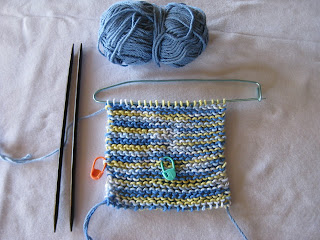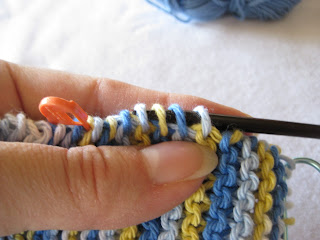So that is my pitiful excuse for being horribly behind on my edge tutorials!
So, without further ado, let's go to part 3: how to make joins.
Written instructions for the border pattern
It seems a fair amount of you had trouble reading the written instructions at the bottom of the chart for the pattern, so here are true-blue written instructions:
R1 (RS): Sl WYIB, p1, k1, yo, k2tog, p1, yo, k1, yo, k2, k2tog (12 st).
R2 (WS): p6, k2, yo, k2tog, k1, ktbl together with a border stitch (J).
R3: Sl WYIB, p1, k1, yo, k2tog, p1, k1, yo, k1, yo, k2, k2tog (13 st).
R4: p7, k2, yo, k2tog, k1, J.
R5: Sl WYIB, p1, k1, yo, k2tog, p1, k2, yo, k1, yo, k2, k2tog (14 st).
R6: p8, k2, yo, k2tog, k1, J.
R7: Sl WYIB, p1, k1, yo, k2tog, p1, k3, yo, k1, yo, k2, k2tog (15 st).
R8: p9, k2, yo, k2tog, k1, J.
R9: Sl WYIB, p1, k1, yo, k2tog, p1, k4, yo, k1, yo, k2, k2tog (16 st).
R10: p10, k2, yo, k2tog, k1, J.
R11: Sl WYIB, p1, k1, yo, k2tog, p1, k8, k2tog (15 st).
R12: p2, pass first stitch over second to cast it off, cast off the following 3 stitches, p4, k2, yo, k2tog, k1, J. (11 st)
This magnificent pictorial shows the different parts of a edged piece. First, we have the center panel, which is the finished dishcloth or shawl or blankie or whatever piece we want to edge.
Side A is (are) the cast on and cast off borders, and our edge stitches will attach to each of the cast on/off stitches. Our stitch/join count will be whatever our cast on/off count was.
Side B are the selvedges, and our edge stitches will attach to stitches picked up from the selvedge. Many shawls will have a garter stitch selvedge, which makes it very simple to pick up stitches. You will pick up one stitch every 2 rows (= each garter ridge), and therefore your stitch/join count will be one half of the total row count.
Corners (C) share a few stitches from side B and a few from side A where the center panel stitches will be joined to the edge more than once (2 times = double join or 3 times = triple join) to achieve the turn of the corner. How many stitches are needed is a function of the width of the edge and your own preference.
Let's begin and leave the math for later
Here is what you need:
- Your little center piece, where you will place a marker show the right side (obvious when you have a pattern, but not so obvious with garter. (*although this is of little consequence on a garter dishcloth, you want to learn to do this so the right side of the edge aligns with the right side of the center piece for mostly everything else! nothing worse than realizing you have the sides wrong after a few repeats).
- Your needles. I prefer DPNs because they don't tangle and it is easy to pick up stitches on either end.
- Your yarn, duh!
- We are going to place a second marker along the left side, about 6-7 garter ridges above the bottom edge (here an orange locking marker)
We will begin our border at the left edge marker, and proceed clockwise. We do not begin at the very tip of the corner because it would make finishing more messy, and we need a little room in case we need to adjust our stitch count.
Pick up a few stitches above our start mark. As you can see, we pick up the garter "bumps" on the side. One stitch per bump, (=one stitch per garter ridge, which equals one stitch per 2 rows of the center panel). In a small piece like this you could pick up all the side stitches, but for a large piece you don't want to do that - just pick up a few, and when those are gone, pick up more as you go.
Using your favorite provisional cast on, cast on 11 stitches on a second needle. Here I am using the "blind" method
Knit the first row (R1) of the pattern using the needle with all the stitches picked up as your right side needle, and the end closest to the bottom end (the start mark). Do NOT slip the first stitch, just this one time. When you finish, your stitches will be sitting on the needle next to the picked up ones.
 |
| ktog-tbl one edge and one selvedge stitch |
 |
| Here is another view |
You will continue working through the edge pattern, making a Single Join at the end of each WS row. This will consume one selvedge stitch each time and will attach your border as you go seamlessly.
Once you get to the corners, you will need to work multiple joins (double or triple - anything larger is too bulky and unsightly). Here is how they work:
Make your K-tbl the same way you would do for a single join, but do NOT drop both stitches from the needle
In fact, drop only the first stitch (which corresponded to an edge stitch) and keep the second one (the selvedge stitch) on the needle
Turn work, knit a RS row, and on the next WS row, knit the last stitch together with the same selvedge stitch you kept on the needle.
If you are going to work a triple join, repeat the last two steps again (drop only the first stitch, knit another two rows, make one more join in yet the same selvedge stitch).
Drop the stitches off the needle, and here you have a double join : 4 edge row stitches joined to a single selvedge stitch.
Turning the corner thus is achieved through a combination of double and triple joins at the corners. Exactly how many and how they are distributed depends heavily on how big the border is and your personal taste and gauge.
As a general rule, a medium edge (10-20 sts) such as the Aspen Leaf we use will need 6-8 DJ and 1 TJ per corner, and a wide edge, such as the Barege/Aspen we use on the KALendar (21 to 30 sts) will need 8 DJ and 1-4 TJ. Those are numbers quoted from Jane Sowerby's Victorian Lace Today, and I find them to be very accurate.
We will stop our tutorial here for now. Our fourth issue, which will come out as soon as I can manage, will deal with the math aspects: calculating your corner joins, and adjusting the join count to make your pattern seamlessly perfect. I have the worksheet ready to go, finally! The last and fifth issue will deal a little bit with the finishing part: grafting both sides together and such.
So when is the actual border instructions coming out?
I have began writing the actual border instructions, but they will be very bare and tailored to the stitch counts in the pattern, therefore if you did some variations, you will need the worksheet and the tutorial to figure it out. I have a head start on my own border, and I know it is going to take me a very, very long time to finish!
Future KAL plans
Some of you have asked... and yes, there are some plans for a 2011 issue! With some differences: new theme, a smaller sized shawl, and a shorter duration of the KAL since a lot of you seem to fizzle around halfway through it. Hopefully a better yardage estimate but who knows... why missing the fun of scrambling for yarn in the last minute?
There is a good chance however that a new KAL won't start until February or March, to allow me to finish the 2010 pattern version, catch up with my horribly backlogged knitting and designing, and maybe, some fun knitting of my own! This is being very intense, compounded by two patterns that are on deadline right now.
However, we can talk about it and plan about it well before hand. Once the edge issues are all done, we can start discussing the theme and some other details. In fact, I would like to do a small online survey to see what you have liked best, in order to maximize the fun!!!













No comments:
Post a Comment